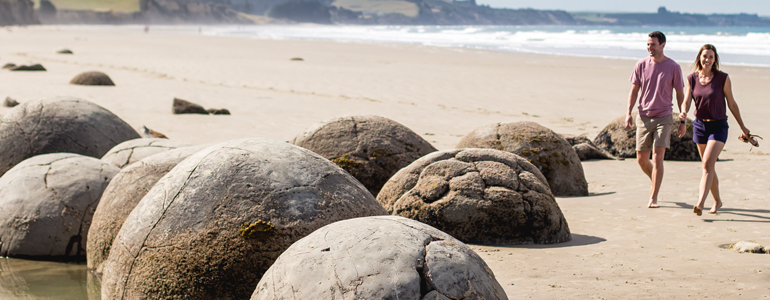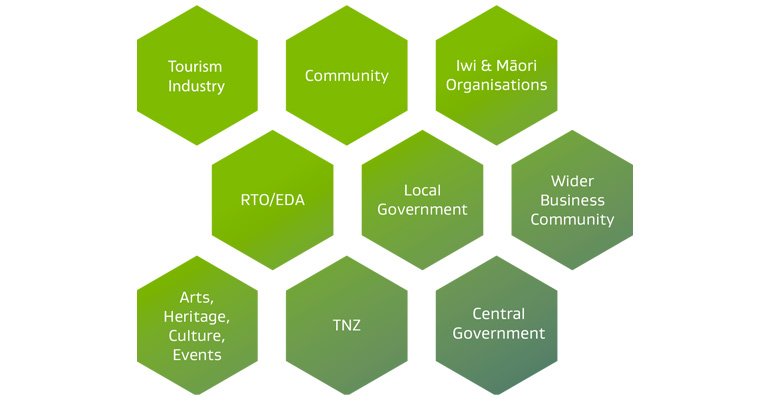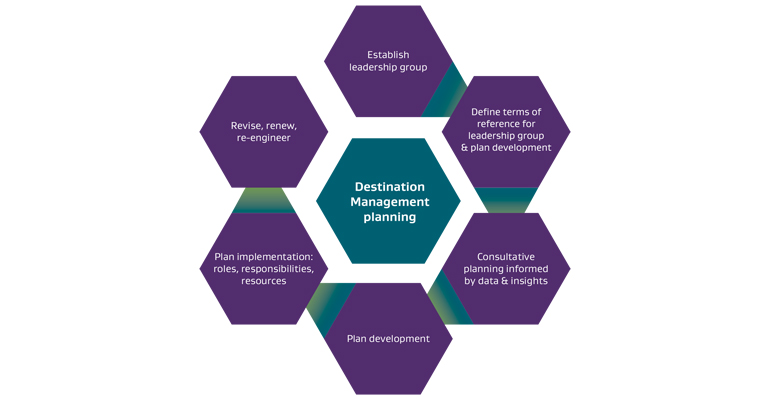Developing a Destination Management plan
On this page

Miles Holden, Moeraki, Otago
Destination Management (DM) planning can apply to a macro-area (e.g. South Island), region (e.g. Taupō Region), district (e.g. Clutha District) or specific location (e.g. Milford Sound). All of these layers are relevant in the context of the destination and stakeholder needs.
Stakeholders will determine what constitutes a ‘destination’, depending on who is leading/facilitating the development of a DM plan, the way visitors experience the place, clusters of activity and communities of interest. Also relevant is the resources and structures supporting the destination, such as RTOs, EDAs and local government authorities.
Collaborative and ongoing process
DM is an ongoing collaborative process. It requires inclusive and coordinated leadership that enables various stakeholders to come together to form a common goal and an agreed vision of success to which they are all committed. It needs to engage residents, tourism enterprises, businesses, Māori/iwi/hapū, RTOs, EDAs, TNZ and local/regional and central government as appropriate.

Diagram description
Commitment and resources
Embarking on a new DM planning process can be a lengthy exercise requiring a reasonable degree of commitment and resourcing. Stakeholders need to be clear about what they want to achieve and be mindful of the resources, capability and capacity available to develop and implement the plan. Small steps can be taken and built on over time as capacity and resources become available.
Many aspects of DM could already be captured in existing plans. Some destinations may want to take a light touch approach, coordinating components of existing plans and identifying gaps and new areas to focus on. Other destinations may choose to embark on a full DM planning process.
Whether you choose a light touch or detailed approach, be clear about why you are developing a plan, who needs to be involved with clearly defined roles and responsibilities and how the plan will be implemented (and funded).
A detailed approach requires an appropriate governance/ leadership structure to lead and coordinate the DM planning process. This could be one lead agency or a consortium as agreed by relevant stakeholders and sponsors. Identifying the right people with the right skills is important as well as ensuring they have the appropriate support and mandate. Destinations can be at different stages of maturity and stakeholders can have different views on the size and scale of tourism that is appropriate. Effective DM is a long term commitment, stakeholders should determine the scope and approach that best serve the destination’s interests and aspirations.
![]()
DM plans should focus on activation and critically determine key areas that are realistic and achievable.
Additional resources may be required to support the development and implementation of the plan; therefore, the process needs to be cognisant of central and local government planning and funding cycles. DM should aim to provide continuity of activity across both political and planning cycles, to provide confidence for stakeholder commitment and investment.

Diagram description
Fit for purpose
To remain fit for purpose, successful destinations regularly revise, review and re-engineer their plans, activities and structures to respond to changing visitor or community needs and the macro- and microeconomic influences.
Regardless of the approach, ambitious visions and comprehensive programmes of activity are commendable; however, DM plans should be realistic and focus on achievable outcomes, with short, medium and long-term priorities and actions.
Tourism Funding Toolkit for Local Government Revenue
The Tourism Funding Toolkit for Local Government Revenue (the Toolkit) has been developed as a resource for local governments to meet the range of tourism costs incurred – from building and maintaining infrastructure that supports tourism, operational costs for services, and the costs associated with implementing regional tourism priorities through, for example, the development of Destination Management Plans.
Case study
Southland Murihiku Destination Strategy 2019-2029
“The 10-year Strategy highlights the importance of destination management and presents a positive vision for the future where Southland.
The Strategy has a strong commitment to embrace a holistic approach to sustainably growing the visitor economy, looking at all the elements that contribute to the overall visitor experience and having these at the centre of positioning Southland as a sought-after travel destination.
The process to develop the Strategy has been extremely valuable, with significant consultation and stakeholder engagement ensuring the strategy vision had broad representation and was inclusive and reflective of the regional tourism sector.
Through this process we have been able to align private and public sectors that equally recognises the host community, local businesses, the environment and of course our visitors. Many of the recommendations made will not only influence the visitor economy but help to make Southland a better place to live helping to ensure the benefits of tourism are shared across the whole region.”
Bobbi Brown, GM Tourism & Events, Great South

